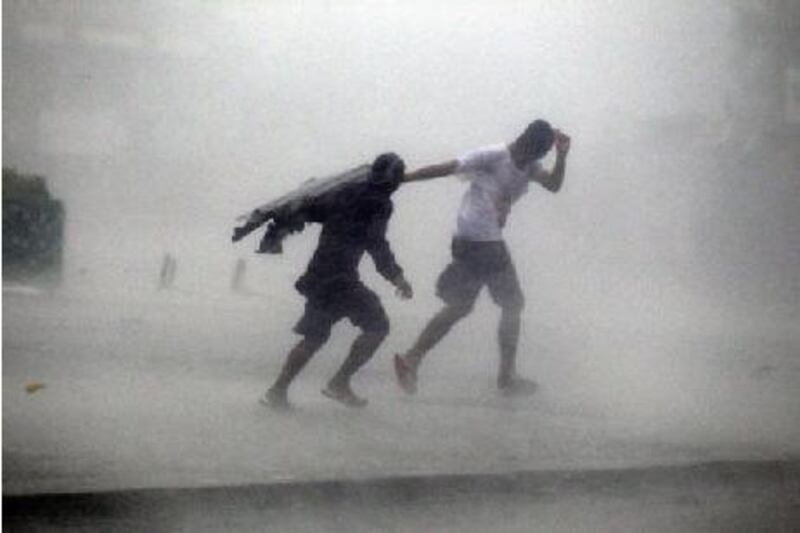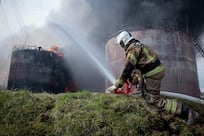BEIJING // The super typhoon Megi struck the northern Philippines yesterday, killing at least three people as it caused landslides, brought down power lines, felled trees and tore roofs off houses.
The most powerful typhoon to hit the country in four years, Megi reached the province of Isabela in the north-east of Luzon island, at 11.25am yesterday, whipping up heavy waves at coastal resorts.
Provincial officials declared a state of calamity as thousands of people who were evacuated to public shelters waited for it to pass over.
Across Luzon, one man was presumed drowned and two people were killed by falling trees, while others were injured.
The death toll from the typhoon, known as Juan in the Philippines, could rise as the full extent of the damage emerges. Many areas were cut off from communications yesterday.
In Vietnam, flooding from a separate weather system was thought to have killed 20 people yesterday when the bus they were travelling in was swept away. Among those presumed dead was a child dragged by the raging waters from its mother's arms. Flooding has killed 32 others in Vietnam in recent days.
In the Philippines, large parts of northern Luzon were without power yesterday and landslides and fallen trees blocked many roads. "There are landslides in the mountains, we have swells, storm surges and big waves along the coastline, and now we have flood alerts," Graciano Yumol, a chief weather forecaster, told a Philippine television station.
Meteorologists recorded winds of 225kph and said the typhoon lost force as it reached mountainous areas, although it was still powerful enough to tear trees apart in western parts of Luzon.
"There's almost zero visibility in some areas due to heavy rain and strong wind," said Lt Gen Gaudencio Pangilinan, the military head in north Luzon.
Rising waters made many bridges impassable, according to Alvaro Antonio, the governor of Cagayan province.
"You cannot travel. It is very dangerous even if you use a vehicle. The wind is very strong and the rains are getting stronger," he said.
The Philippine Atmospheric, Geophysical and Astronomical Services Administration issued a level four alert - its highest - for Cagayan, Isabela, Mountain, Ifugao and Kalinga provinces, the last of which is one of the country's most remote highland areas, home to many villages without road links. State weather forecasters warned that mountainous regions were particularly prone to flooding.
A man who slipped and fell into a river in Cagayan province after rescuing his water buffalo was believed to have drowned. Also a woman in Kalinga province and a male security guard in Baguio city died after being hit by falling trees.
More than 3,000 people had been moved to safer areas before the typhoon's arrival by authorities who have extensive experience dealing with extreme weather in a country struck by an average of 20 typhoons annually.
Schools were closed and sea crossings and flights to northern parts of the country were cancelled. Officials feared as many as 200,000 tonnes of unharvested rice could be lost.
Anton Carag, 49, a tour guide based in Tuguegarao, the capital of Cagayan, said the city yesterday was much quieter than usual, with most people staying indoors as winds battered the city. He described heavy damage outside his house.
"Most of my tree branches are broken," he said by telephone. "One of my trees has been turned over and one of my windows blown out - it must have been hit by something. There are probably a lot of things flying around. The winds are quite strong."
In Santiago, a city in Isabela province, Jean Jamias, a receptionist at the Hotel Amancio, said heavy winds began to blow at about 1pm. She said there was little visible damage, however, and people were able to walk outside.
Further west, in Baguio city, pictures showed roads blocked by large branches ripped away by the heavy winds.
Megi, which means catfish in Korean, is the 10th typhoon to hit the Philippines this year, and the strongest so far this year.
It is the worst of its kind since Typhoon Durian struck in 2006, triggering mudslides that killed more than 1,000 people.
Although it was reported to have lost force over the Philippines, Megi is expected to pick up strength again over the South China Sea, which it was due to reach last night. It is likely to slam into mainland China west of Hong Kong.
The storm is likely to bring more misery to Hainan, a Chinese island province which in recent weeks has suffered its worst flooding for decades. Already, rains that started on Friday have led to the evacuation of 140,000 people, according to the state Xinhua news agency. Villages have been inundated, crops flooded and houses damaged.
The typhoon is also expected to hit Vietnam, already reeling from heavy flooding in the past few days. At least 64 people died during another bout of flooding in central Vietnam this month.
* With additional reporting by Agence France-Presse and Associated Press






